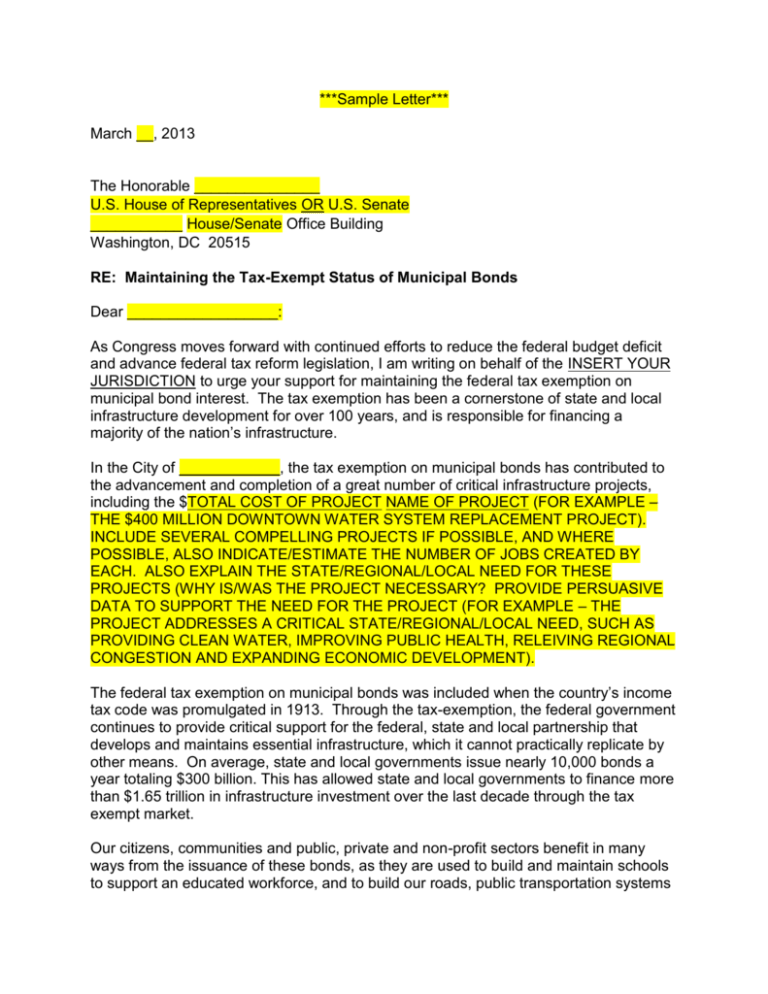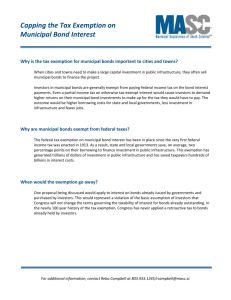***Sample Letter*** March __, 2013 The Honorable U.S. House of
advertisement

***Sample Letter*** March __, 2013 The Honorable _______________ U.S. House of Representatives OR U.S. Senate ___________ House/Senate Office Building Washington, DC 20515 RE: Maintaining the Tax-Exempt Status of Municipal Bonds Dear __________________: As Congress moves forward with continued efforts to reduce the federal budget deficit and advance federal tax reform legislation, I am writing on behalf of the INSERT YOUR JURISDICTION to urge your support for maintaining the federal tax exemption on municipal bond interest. The tax exemption has been a cornerstone of state and local infrastructure development for over 100 years, and is responsible for financing a majority of the nation’s infrastructure. In the City of ____________, the tax exemption on municipal bonds has contributed to the advancement and completion of a great number of critical infrastructure projects, including the $TOTAL COST OF PROJECT NAME OF PROJECT (FOR EXAMPLE – THE $400 MILLION DOWNTOWN WATER SYSTEM REPLACEMENT PROJECT). INCLUDE SEVERAL COMPELLING PROJECTS IF POSSIBLE, AND WHERE POSSIBLE, ALSO INDICATE/ESTIMATE THE NUMBER OF JOBS CREATED BY EACH. ALSO EXPLAIN THE STATE/REGIONAL/LOCAL NEED FOR THESE PROJECTS (WHY IS/WAS THE PROJECT NECESSARY? PROVIDE PERSUASIVE DATA TO SUPPORT THE NEED FOR THE PROJECT (FOR EXAMPLE – THE PROJECT ADDRESSES A CRITICAL STATE/REGIONAL/LOCAL NEED, SUCH AS PROVIDING CLEAN WATER, IMPROVING PUBLIC HEALTH, RELEIVING REGIONAL CONGESTION AND EXPANDING ECONOMIC DEVELOPMENT). The federal tax exemption on municipal bonds was included when the country’s income tax code was promulgated in 1913. Through the tax-exemption, the federal government continues to provide critical support for the federal, state and local partnership that develops and maintains essential infrastructure, which it cannot practically replicate by other means. On average, state and local governments issue nearly 10,000 bonds a year totaling $300 billion. This has allowed state and local governments to finance more than $1.65 trillion in infrastructure investment over the last decade through the tax exempt market. Our citizens, communities and public, private and non-profit sectors benefit in many ways from the issuance of these bonds, as they are used to build and maintain schools to support an educated workforce, and to build our roads, public transportation systems and airports, all of which are essential for supporting commerce. They also help to address the country’s water infrastructure, public utilities, health care and affordable housing needs, as well as provide public safety infrastructure that ensures local and national security. These financings are approved by elected bodies at the state and local levels or by the voters themselves for specific long-term projects, not to support general government functions, such as maintaining employees or keeping the lights on. As the federal government continues to develop policies to reduce the deficit, several proposals have been offered that would replace, limit, or eliminate the tax exempt status of municipal bond interest. To support these proposals it has been suggested that those who truly benefit from the municipal tax exemption are wealthy investors. These claims mischaracterize municipal investors and the true beneficiaries of municipal bonds, who are – state and local governments who need the support of investors to finance critical infrastructure; taxpayers across the country who depend on this infrastructure for reliable transportation systems, schools, public health facilities, energy, clean water and affordable housing; the federal government, who is able to provide a small tax benefit for a return of billions of dollars of infrastructure; and investors who buy bonds for many reasons, including the safe nature of these financial products. It is worth noting that 72.4 percent of the total outstanding muni debt is held by individual investors, either directly or through mutual funds and money market funds (Source - 2010 Thomson Reuters). 2010 IRS data indicates that 57 percent of tax exempt income is reported by earners over the age of 65. These are individuals who are largely on fixed incomes, expecting the secure return on investment that municipal bonds provide. Municipal bonds are the second safest investment, aside from U.S. Treasuries, with state and local governments having nearly a zero default rate. 2010 IRS data also indicates that 52 percent of all bond interest paid to individuals went to those with incomes of less than $250,000. Investors in municipal bonds are those who want to support the long-term infrastructure needs of their communities through a direct investment that cannot be replaced by any direct funding source or entity, including the federal, state or local governments. Proposals to reduce or repeal the tax exemption would have severely detrimental impacts on national infrastructure development and the municipal bond market, raising costs for state and local borrowers and creating uncertainty for investors. For example, it is estimated that if the proposal to cap the exemption on municipal bonds at 28 percent had been in place over the last 10 years it would have cost state and local governments an additional $173 billion in interest costs. Total repeal of the exemption over that time would have cost state and local governments over $495 billion in additional interest costs. Given the severe budget constraints that state and local governments have faced since the national financial crisis of 2008, it is very likely that many of the infrastructure projects funded through tax exempt bonds would not have been possible. Speaking specifically to the impacts on the City of _____________, these proposals would INSERT THE IMPACT OF A FULL REPEAL OF THE MUNIICPAL TAX EXEMPTION AND THE PROPOSED 28% CAP ON THE EXEMPTION TO YOUR JURISDICTION (INCLUDE ESTIMATED INCREASES IN INTEREST COSTS, COSTS TO TAXPAYERS AS WELL AS QUANTITATIVE ESTIMATED IMPACTS OF SPECIFIC PROJECTS THAT WILL BE DELAYED OR CANCELLED SHOULD EITHER OF THESE PROPOSALS BE ENACTED). Proposals to cap or repeal the exemption would also introduce uncertainty into the municipal market, causing investors to fear additional federal intervention in the market where none has existed for the past 100 years. Ultimately these investor concerns translate into demands for higher yields from and increased costs to state and local governments. If these entities are unable to satisfy investor yield demands, then either needed infrastructure projects will not move forward or the costs of these projects will be passed on directly to state and local tax and rate payers. The municipal tax exemption has a long history of success, having been maintained through two world wars and the Great Depression, as well as the recent Great Recession, and it continues to finance the majority of our nation’s infrastructure needs for state and local governments of all sizes when no other source exists to do so. We cannot afford to abandon the great success of this important financing instrument, especially as state and local governments continue to recover from the economic downturn. Thank you for your attention to our concerns on this important economic development issue. Please contact _______________ at _______________ if you have any questions or need any additional information. Sincerely, cc: Jennifer Whiting, League of California Cities, jwhiting@cacities.org





